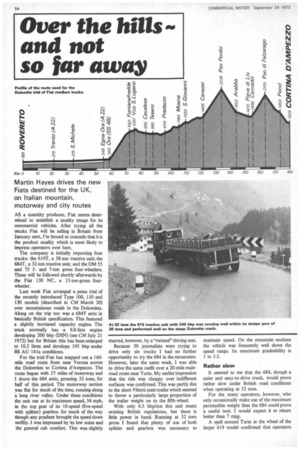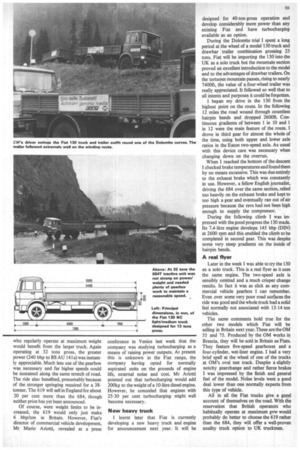Over the hills and not so far away
Page 56

Page 57

If you've noticed an error in this article please click here to report it so we can fix it.
Martin Hayes drives the new Fiats destined for the UK, on Italian mountain, motorway and city routes
AS a quantity producer, Fiat seems determined to establish a quality image for its commercial vehicles After trying all the trucks Fiat will be selling in Britain from January next, I'm bound to concede that it is the product quality which is most likely to impress operators over here.
The company is initially importing four trucks: the 619T, a 38-ton tractive unit; the 684T, a 32-ton tractive unit; and the OM 55 and 75 5and 7-ton gross four-wheelers. These will be followed shortly afterwards by the Fiat 130 NC, a 13-ton-gross fourwheeler.
Last week Fiat arranged a press trial of the recently introduced Type 100, 110 and 130 models (described in CM March 30) over mountainous roads in the Dolomites. Along on the trip too was a 684T ariic in basically British specification. This featured a slightly increased capacity engine. The truck normally has a 9.8-litre engine developing 200 bhp (DIN) (see CM July 21 1972) but for Britain this has been enlarged to 10.3 litres and develops 195 bhp under BS AU 141a conditions.
For the trial Fiat has mapped out a 160mile road route from near Verona across the Dolomites to Cortina d'Ampezzo. The route began with 37 miles of motorway and I drove the 684 artic, grossing 32 tons, for half of this period. The motorway section was flat for much of the time, running along a long river valley. Under these conditions the unit ran at its maximum speed, 54 mph, in the top gear of its I0-speed (five-speed With splitter) gearbox for much of the way though any gradient brought the speed down swiftly. I was impressed by its low noise and the general cab comfort. This was slightly marred, however, by a "twisted". driving seat.
Because 30 journalists were trying to drive only six trucks I had no further opportunity to try the 684 in the mountains. However, later the same week, I was able to drive the same outfit over a 20-mile mainroad route near Turin. My earlier impression that the ride was choppy over indifferent surfaces was confirmed. This was partly due to the short Viberti semi-trailer which seemed to throw a particularly large proportion of the trailer weight on to the fifth-wheel.
With only 6.5 bhp/ton this unit meets existing British . regulations, but there is little power in hand. Running at 32 tons gross I found that plenty of use of both splitter and gearbox was necessary to maintain speed. On the mountain sections the vehicle was frequently well down the speed range. Its maximum gradeability is 1 in 5.5.
Rather slow
It seemed to me that the 684, though a quiet and easy-to-drive truck, would prove rather slow under British road conditions when operating at 32 tons.
For the many operators, however, who only occasionally make use of the maximum permissible weight then the 684 could prove a useful tool. I would expect it to return better than 7 mpg.
A spell around Turin at the wheel of the larger 619 model confirmed that operators who regularly operate at maximum weight would benefit from the larger truck. Again operating at 32 tons gross, the greater power (240 bhp to BS AU 1 4 1a) was instantly appreciable. Much less use of the gearbox was necessary and far higher speeds could be sustained along the same stretch of road. The ride also benefited, presumably because of the stronger springing required for a 38tonner. The 619 will sell in England for about 20 per cent more than the 684, though neither price has yet been announced.
Of course, were weight limits to be increased, the 619 would only just make 6 bhp/ton in Britain. However, Fiat's director of commercial vehicle development, Mr Mario Ariotti, revealed at a press conference in Venice last week that the company was studying turbocharging as a means of raising power outputs. At present this is unknown in the Fiat range, the company having opted for normally aspirated units on the grounds of engine life, external noise and cost. Mr Ariotti pointed out that turbocharging would add 200kg to the weight of a 10-litre diesel engine. However, he conceded that engines with 25-30 per cent turbocharging might well become necessary.
New heavy truck I learnt later that Fiat is currently developing a new heavy truck and engine for announcement next year. It will be designed for 40-ton-gross operation and develop considerably more power than any existing Fiat and have turbocharging available as an option.
During the Dolomite trial I spent a long period at the wheel of a model 130 truck and drawbar trailer combination grossing 23 tons. Fiat will be importing the 130 into the UK as a solo truck but the mountain section proved an excellent introduction to the model and to the advantages of drawbar trailers. On the tortuous mountain passes, rising to nearly 7400ft, the value of a four-wheel trailer was really appreciated. It followed so well that to all intents and purposes it could be forgotten.
I began my drive in the 130 from the highest point on the route. In the following 12 miles the road wound through countless hairpin bends and dropped 2600ft. Continuous gradients of between 1 in 10 and 1 in 12 were the main feature of the route. I drove in third gear for almost the whole of the time, using both upper and lower axle ratios in the Eaton two-speed. axle. As usual with this device care was necessary when changing down on the overrun, When I reached the bottom of the descent I checked brake temperatures and foundthem by no means excessive. This was due entirely to the exhaust brake which was constantly in use. However, a fellow English journalist, driving the 684 over the same section, relied too heavily on the exhaust brake and kept to too high a gear and eventually ran out of air pressure because the revs had not been high enough to supply the compressor.
During the following climb I was impressed with the good progress the 130 made. Its 7.4-litre engine develops 145 bhp (DIN) at 2600 rpm and this enabled the climb to be completed in second gear. This was despite some very steep gradients on the inside of hairpin bends.
A real flyer Later in the week I was able to try the 130 as a solo truck. This is a real flyer as it uses the same engine. The two-speed axle is sensibly omitted and a much crisper change results. In fact it was as slick as any commercial vehicle gearbox I can remember. Even over some very poor road surfaces the ride was good and the whole truck had a solid feel normally not associated with 13-14 ton vehicles.
The same comments hold true for the other two models which Fiat will be selling in Britain next year. These are the OM 55 and 75. Produced by the OM works in Brescia, they will be sold in Britain as Fiats. They feature five-speed gearboxes and a four-cylinder, wet-liner engine. I had a very brief spell at the wheel of one of the trucks at OM's oval test track. Despite a slightly notchy gearchange and rather fierce brakes I was impressed by the finish and general feel of the model. Noise levels were a good deal lower than one normally expects from this type of vehicle.
All in all the Fiat trucks give a good account of themselves on the road. With the reservation that British operators who habitually operate at maximum gvw would probably do better to choose the 619 rather than the 684, they will offer a well-proven quality truck option to UK truckmen.












































































































